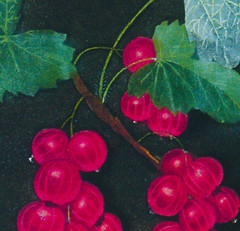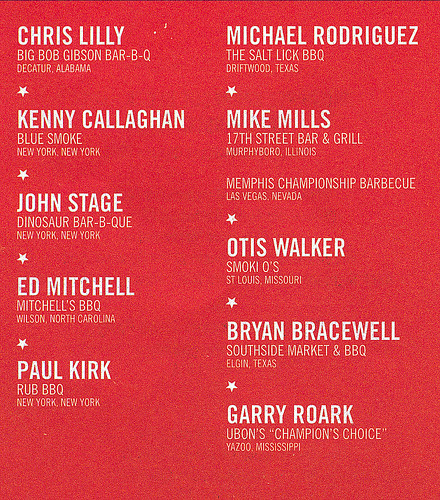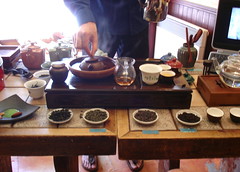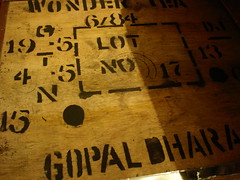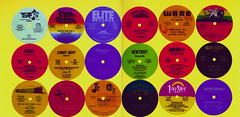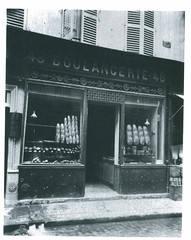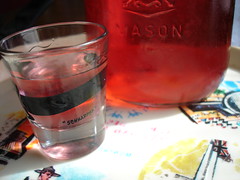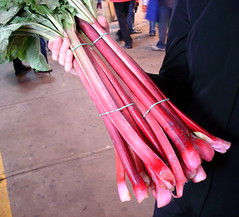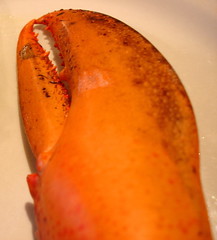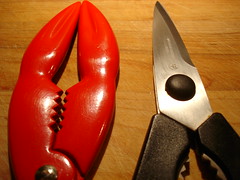One reason we could afford to be cavalier about our bbq bust at the Big Apple Barbecue Block Party was because by that time we were already in the midst of the survey (an ever so brief one, given we were only in New York for 2 1/2 days) we'd decided would be the focus of our trip: noodle shops. Noodle shops? Well, Michelle had had an almost monomaniacal fixation on New York's noodle shops and on Momofuku in particular for several months before we made it down. She'd been following the press on Momofuku and its delirious take on Asian street and counter food closely, but things reached critical mass when Momofuku chef David Chang's girlfriend paid a visit to Les Chèvres a few weeks ago. Michelle got to talking her up, she got herself even more revved up about Momofuku than she'd been up to that point (I wasn't sure that was possible), and when she came back from her shift that night she just looked me dead in the eyes and said, "Pack your bags." So, we went to New York knowing we were going to be paying Momofuku a visit, but when we arrived we hadn't yet settled on a theme for our visit. Which tour was it going to be? In search of real Italian-American pizza? The Latino explosión? Kosher Cuban-Chinese, the untold story? We looked into the pizza option quite seriously: we solicited opinions, gauged preferences, and took notes. Based on our research, we decided that no pizza survey would be complete without a trip to the legendary DiFara in Brooklyn, where every pie is made with care by the proprietor, Dom, and the artichoke pizza involves gently sauteeing the artichoke for a full 30 minutes before topping the pizza with it. The thing is, we'd heard that DiFara had been closed unexpectedly a couple of times in recent months for reasons having to do with health. Dom's getting up there in age, we were told, and seeing as he's the only one who handles the pies at DiFara, they haven't always been able to open up on schedule recently. We called DiFara repeatedly over the course of a couple of days but never managed to get through. After everything we'd heard and read about the place, the thought of carrying out a pizza survey without going to DiFara and having some of that artichoke pie seemed anti-climactic, to say the least, so we started to consider alternatives. And seeing as we were already had our sights set on Momofuku and, god knows, we're starved for quality noodles shops of any and all stripes here in Montreal (Michelle tried to impress this upon Mr. Chang's girlfriend: we need quality Asian counter food here now), we just shifted gears a bit and started to think "noodles." Suddenly the geography of our research changed quite drastically; now, all of a sudden, instead of having a quest that might very well have taken us from South Brooklyn, to Lower Manhattan, to Harlem, we were very much concentrated on the East Village and Chinatown and that suited us just fine.
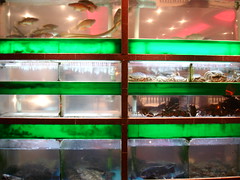 fig. a: just some of the mysteries of Chinatown
fig. a: just some of the mysteries of Chinatown
Now, among all the other things that are radically different about New York's food culture as compared to that of a city like Montreal, one of the most striking is just how politicized it is. People have their opinions here in Montreal, sure, but they're rarely all that vehement about them. They're divided over things like where to find the best bagels, the best smoked meat, the best steak, and maybe the best Portuguese, Greek, or Indian, but it's rare that you feel like you've touched a nerve with someone when you bring up such matters. In fact, we find ourselves constantly trying to provoke these kinds of heated discussions, but unfortunately no one ever takes the bait. Go to New York, however, talk to the right people, and you find that nearly every food issue is highly divisive, splintering people into myriad competing camps. For a city of its size, Montreal's culinary side is impressive, but New York has so much more to offer and so many more people who take these things seriously, and the stakes are so much higher. I guess it should come as no surprise that culture wars are waged each and every day there over the subject of food. Bring up the topic of noodle shops with any New Yorker who happens to take their dining seriously and you might very well end up in a firestorm.
Ultimately we settled on four noodle shops, two Chinese and two Japanese (definitely not tons for a survey, but not bad considering we hit three of them over a 15-hour span). We lapped up the BBQ dishes at N.Y. Noodle Town, like the BBQ duck and the spare ribs, and the dumplings at Wonton Garden (like these lovely shrimp dumplings)
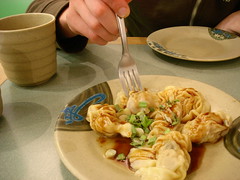 fig. b: shrimp dumplings at New Wonton Garden
fig. b: shrimp dumplings at New Wonton Garden
always blow our minds, but it was the Japanese noodle dishes we were craving the most because Montreal is a veritable desert in the Japanese noodle department and neither of us has quite been the same since we left Vancouver behind, where we'd eaten ramen, udon, gyoza, and other Japanese noodle bar classics regularly.
Japanese noodle stop #1 was Rai Rai Ken and when we got there I thought I was dreaming. It'd be hard to imagine a more perfectly classic Japanese noodle bar. I mean, just look at that entrance.
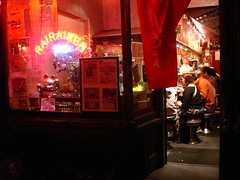 fig. c: Rai Rai Ken from 10th St.
fig. c: Rai Rai Ken from 10th St.
We started with an order of pan-fried gyoza stuffed with pork and shrimp and a bowl of edamame to nibble on, then made up our minds about our ramen selections. There were four of us out together, so between the lot of us we were able to try every variation of ramen available from their small menu. We ended up ordering two shoyu ramens, one shio, and one miso. All three varieties came with braised bamboo shoots, hard-boiled egg, one of those distinctive pink fish cakes, a healthy slice of pork, spinach, a sheet of seaweed, and diced scallions.
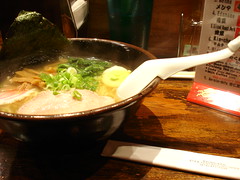 fig. d: perfection incarnate, or shio ramen at Rai Rai Ken
fig. d: perfection incarnate, or shio ramen at Rai Rai Ken
Each of the three broths was delicious, but my favorite was the one I selected, the shio, or seafood broth, which had that perfect combination of flavor and subtlety. The miso broth was one of the boldest, most interesting miso broths I've ever encountered, but I found it a bit too rich for my liking. The shoyu broth was good, but perhaps on bit too strong on the shoyu. All in all, though, these were top-notch ramen soups at very affordable prices, and I can't say enough about the atmosphere. If I lived in New York, I'd be a regular.
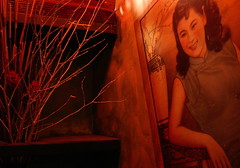 fig. e: decor, Rai Rai Ken
fig. e: decor, Rai Rai Ken
The next day, just before hopping on the FDR and making our way off the $24 island, we stopped back in the East Village to take lunch at Momofuku. Truth be told, this was the second time Michelle had gone that weekend: she'd popped in for a snack the day before and had an order of steamed pork buns. The steamed pork bun had been such a smash hit that she insisted that we order them again--ostensibly, so that I could have the pleasure of trying them, but actually so that she might have her third steamed pork bun in two days. Like a good number of the other offerings at Momofuku, the steamed pork buns come stuffed with the restaurant's signature braised Iowa Berkshire pork.
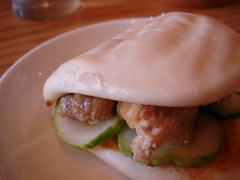 fig. f: steamed pork bun, Momofuku
fig. f: steamed pork bun, Momofuku
You can see it there stuffed within a steamed bun, garnished with cucumber and dressed with a teriyaki-like sauce, and the rumors are true: it's some of the most succulent tasting pork you're likely to find. I still love the purity and unity of a good Chinese pork bun--the inspiration behind this version--but Momofuku's was outstanding, if unconventional, and the cucumber was a surprisingly refreshing addition.
We then proceeded to the main dishes and Michelle ordered the house special Momofuku Ramen, complete with a "Berkshire pork combo." Many of Momofuku's specialties are based on the notion of taking some kind of classic dish--a steamed pork bun, say--and staying true to its basic architecture, while making some key substitutions. Their ramen is no exception. Staples like the braised bamboo shoots, seaweed, fish cake, and diced scallions are all there, but peas appear in place of a green like spinach, the egg is poached instead of boiled, Chang replaces the standard cut of pork typical of the Japanese ramen with two different types of his Berkshire pork--his braised pork and a few generous slices of fatty, ultra-flavorful pork belly--and the only broth available is his unexpectedly subtle house pork broth. As tasty as the pork belly was, it had the effect of turning the Momofuku Ramen into an event, and Michelle confessed that the next time she'd opt for the more subdued "ramen with shredded Berkshire pork" (which, at $10, is also $4 less than the Momofuku Ramen).
The true revelation of our luncheon, however, was my Ssäm. I have to confess, at the time that I ordered it, I really had little idea what exactly I was ordering. The ingredients--"Berkshire pork, rice, edamame, onions, pickled shiitake, kimchi"--all sounded great to me, but I was expecting some kind of a fried rice dish, or possibly even a rice-based soup. Then, as we ate our appetizers and took in the scene, we started to notice the cooks assembling an intriguing-looking dish that we couldn't quite place. We studied one cook closely for a minute or two and when we were done we turned to each other and said, "That's gotta be the Ssäm." You see, what Chang has done here is that he's taken a Korean street food classic, bo-ssam--one variation on which involves marinated and grilled pork, a spicy condiment made of soy, garlic, and chili paste, and a pile of lettuce leaves--and teased out some of the similarities it bears to Mexican-American street food, transforming it into a sort of Korean-American burrito, if you can imagine that.
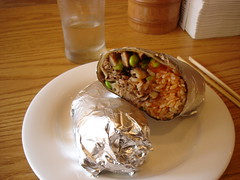 fig g: ssäm, Momofuku
fig g: ssäm, Momofuku
Edamame replace the pinto or black beans, kimchi replaces the salsa, and the tortilla is replaced, ever so cleverly, by a mu shu crêpe, but otherwise the dish is assembled in the way a San Francisco-style burrito would be, right down to the foil wrapper. I'm not one to fall for novelties generally, but when something's this outrageous and, more importantly, this delicious, it's hard to argue. News that Chang is planning on starting up a neighboring counter restaurant in the coming months that will showcase the Ssäm the way Momofuku showcases ramen soups comes as no surprise (even if I still can't figure out what that umlauten is there for).
 fig. h: decor, Momofuku
fig. h: decor, Momofuku
The subject of Momofuku--its food, its rock-n-roll attitude, its decor, etc.--elicits by far and away the strongest reactions from New York's culinary cognoscenti, ranging from positive (hip, tasty) to negative (overhyped, arriviste). We'd heard all the arguments and counter-arguments (no pun intended) by the time we sat down to eat. All I can say is that jumping into the fray has rarely been this pleasurable.
My only regrets of the weekend ("You mean, aside from having missed out on barbecue at the Block Party and never having made it to DiFara for that artichoke pie?")? Not ordering Momofuku's Roasted Long Island Razor Clams with "Kurowycky sausage" (recalling the East Village's Eastern European past) and ginger scallion sauce, and, even more importantly, not finding the time for Minca, yet another popular East Village noodle haunt. Next time.
N.Y. Noodle Town, 28 Bowery St., (212) 349-0923
New Wonton Garden, 56 Mott St., (212) 966-4886
Rai Rai Ken, 214 E. 10th St., (212) 477-7030
Momofuku, 163 1st Ave, (212) 475-7899
aj
 fig. a: New York Dock Co.
fig. a: New York Dock Co. fig. b: tramcar
fig. b: tramcar  fig. c: Michelle at Steve's
fig. c: Michelle at Steve's  fig. d: Sunny's
fig. d: Sunny's 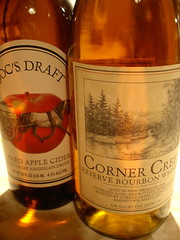 fig. e: hooch from LeNell's
fig. e: hooch from LeNell's 